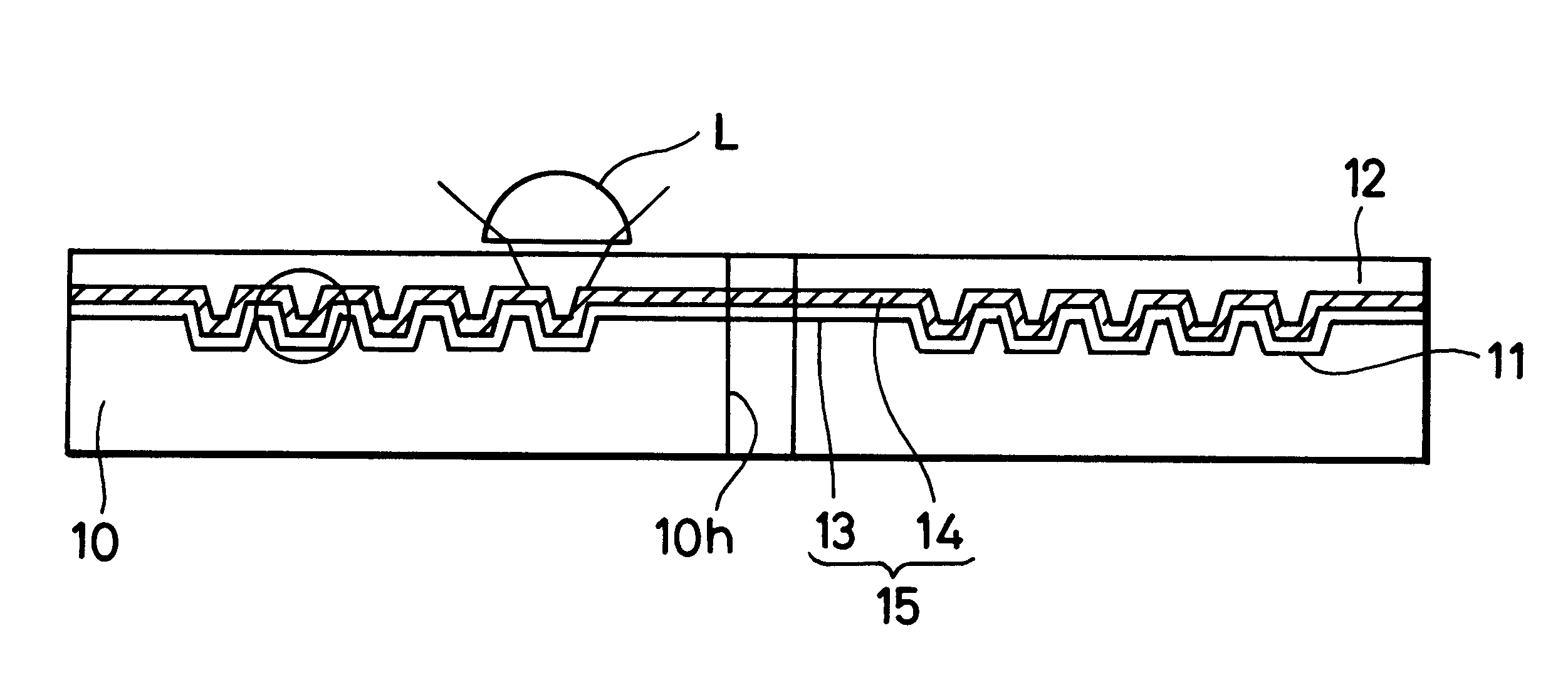Reduced thickness of a light transmissive layer for a high density optical disc
- Summary
- Abstract
- Description
- Claims
- Application Information
AI Technical Summary
Benefits of technology
Problems solved by technology
Method used
Image
Examples
second embodiment
The light transmissive layer 12 can be formed by coating a liquid ultraviolet curing resin on the organic dye recording layer 14, drawing the resin, and then curing the resin by irradiation of light. FIG. 5 illustrates an optical recording medium according to the present invention wherein the light transmissive layer 12 can be formed by laminating a light transmissive film 17 having a uniform thickness on a liquid ultraviolet curing resin 16.
In this case, unevenness of the thickness of the light transmissive layer 12 is formed of the light transmissive film 17 and the bonded liquid ultraviolet curing resin 16 can be significantly reduced to 10 .mu.m by placing the light transmissive film 17 having the same diameter as that of the substrate 10 on the substrate 10 through the ultraviolet curing resin 16. The ultraviolet curing resin 16 is then spin coated thereon with the light transmissive film 17 being employed as a weight for the ultraviolet curing resin 16.
In the past, when an org...
third embodiment
FIG. 6 illustrates an optical recording medium according to the present invention wherein a transparent protective layer 18 is formed between the organic dye recording layer 14 and the light transmissive layer 12 in order to prevent the organic dye from being dissolved in the ultraviolet curing resin. This transparent layer 18 is formed of a simple substance or a mixture of an oxide, a nitride, sulfide, fluoride, etc., such as Mg, Al, Si, Ti, Zn, Ga, Ge, Zr, In, Sn, Sb, Ba, Hf, Ta, and of rare-earth elements, such as Sc and Y.
Since a total amount of light refraction at the light transmissive layer 12 and the transparent protective layer 18 must be constant, it is desirable that the thickness of the light transmissive layer 12 satisfies the equation 10-[(1.53d / n)] to 177-[(1.53d) / n] [.mu.m] assuming that the refractivity of the transparent protective layer 18 is n, its film thickness is d and the refractivity of the light transmissive layer 12 is 1.53.
As aforedescribed, the light tra...
fourth embodiment
The present invention also pertains to a multilayer optical recording medium having a plurality of information recording layers each of which is formed of a reflective film and an organic dye recording layer which are laminated on a guide groove. FIG. 7 illustrates an optical recording medium according to the present invention having such a multilayer optical recording medium. This multilayer optical recording medium includes a multilayer optical recording medium having a second information recording layer 15b formed on a first information recording layer 15a which is formed by injection molding of the substrate 10 and separated therefrom by an intermediate layer 19.
PUM
 Login to View More
Login to View More Abstract
Description
Claims
Application Information
 Login to View More
Login to View More - R&D
- Intellectual Property
- Life Sciences
- Materials
- Tech Scout
- Unparalleled Data Quality
- Higher Quality Content
- 60% Fewer Hallucinations
Browse by: Latest US Patents, China's latest patents, Technical Efficacy Thesaurus, Application Domain, Technology Topic, Popular Technical Reports.
© 2025 PatSnap. All rights reserved.Legal|Privacy policy|Modern Slavery Act Transparency Statement|Sitemap|About US| Contact US: help@patsnap.com



